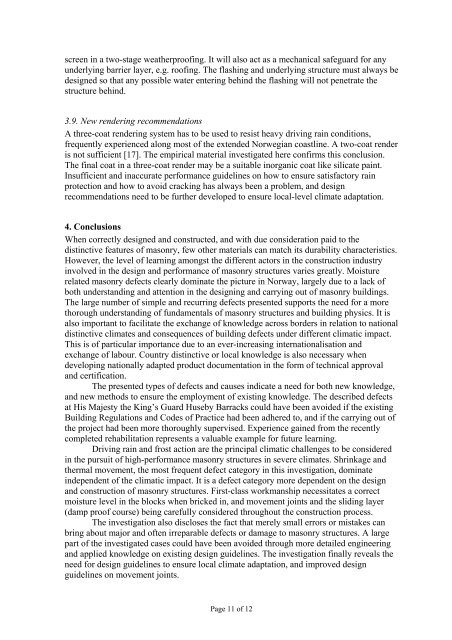Lisø PhD Dissertation Manuscript - NTNU
Lisø PhD Dissertation Manuscript - NTNU
Lisø PhD Dissertation Manuscript - NTNU
You also want an ePaper? Increase the reach of your titles
YUMPU automatically turns print PDFs into web optimized ePapers that Google loves.
screen in a two-stage weatherproofing. It will also act as a mechanical safeguard for any<br />
underlying barrier layer, e.g. roofing. The flashing and underlying structure must always be<br />
designed so that any possible water entering behind the flashing will not penetrate the<br />
structure behind.<br />
3.9. New rendering recommendations<br />
A three-coat rendering system has to be used to resist heavy driving rain conditions,<br />
frequently experienced along most of the extended Norwegian coastline. A two-coat render<br />
is not sufficient [17]. The empirical material investigated here confirms this conclusion.<br />
The final coat in a three-coat render may be a suitable inorganic coat like silicate paint.<br />
Insufficient and inaccurate performance guidelines on how to ensure satisfactory rain<br />
protection and how to avoid cracking has always been a problem, and design<br />
recommendations need to be further developed to ensure local-level climate adaptation.<br />
4. Conclusions<br />
When correctly designed and constructed, and with due consideration paid to the<br />
distinctive features of masonry, few other materials can match its durability characteristics.<br />
However, the level of learning amongst the different actors in the construction industry<br />
involved in the design and performance of masonry structures varies greatly. Moisture<br />
related masonry defects clearly dominate the picture in Norway, largely due to a lack of<br />
both understanding and attention in the designing and carrying out of masonry buildings.<br />
The large number of simple and recurring defects presented supports the need for a more<br />
thorough understanding of fundamentals of masonry structures and building physics. It is<br />
also important to facilitate the exchange of knowledge across borders in relation to national<br />
distinctive climates and consequences of building defects under different climatic impact.<br />
This is of particular importance due to an ever-increasing internationalisation and<br />
exchange of labour. Country distinctive or local knowledge is also necessary when<br />
developing nationally adapted product documentation in the form of technical approval<br />
and certification.<br />
The presented types of defects and causes indicate a need for both new knowledge,<br />
and new methods to ensure the employment of existing knowledge. The described defects<br />
at His Majesty the King’s Guard Huseby Barracks could have been avoided if the existing<br />
Building Regulations and Codes of Practice had been adhered to, and if the carrying out of<br />
the project had been more thoroughly supervised. Experience gained from the recently<br />
completed rehabilitation represents a valuable example for future learning.<br />
Driving rain and frost action are the principal climatic challenges to be considered<br />
in the pursuit of high-performance masonry structures in severe climates. Shrinkage and<br />
thermal movement, the most frequent defect category in this investigation, dominate<br />
independent of the climatic impact. It is a defect category more dependent on the design<br />
and construction of masonry structures. First-class workmanship necessitates a correct<br />
moisture level in the blocks when bricked in, and movement joints and the sliding layer<br />
(damp proof course) being carefully considered throughout the construction process.<br />
The investigation also discloses the fact that merely small errors or mistakes can<br />
bring about major and often irreparable defects or damage to masonry structures. A large<br />
part of the investigated cases could have been avoided through more detailed engineering<br />
and applied knowledge on existing design guidelines. The investigation finally reveals the<br />
need for design guidelines to ensure local climate adaptation, and improved design<br />
guidelines on movement joints.<br />
Page 11 of 12














![Diagnosis and FTC by Prof. Blanke [pdf] - NTNU](https://img.yumpu.com/12483948/1/190x245/diagnosis-and-ftc-by-prof-blanke-pdf-ntnu.jpg?quality=85)

